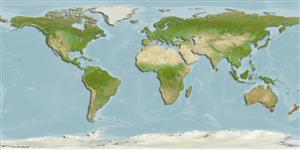Environment: milieu / climate zone / depth range / distribution range
Écologie
marin démersal; profondeur 0 - 7 m (Ref. 84085). Temperate
Southwest Pacific: southeastern Tasmania, Australia and New Zealand.
Taille / Poids / Âge
Maturity: Lm ? range ? - ? cm
Max length : 7.6 cm SL mâle / non sexé; (Ref. 13227)
Description synthétique
Clés d'identification | Morphologie | Morphométrie
Épines dorsales (Total) : 25 - 30; Rayons mous dorsaux (Total) : 14 - 16; Épines anales: 2; Rayons mous anaux: 25 - 27; Vertèbres: 44 - 46. Snout profile steep, line drawn through tip of premaxilla across ventral margin of orbit touches or passes anterodorsal to dorsal extremity of preoperculum. Transverse groove in front of first
dorsal fin containing cephalic sensory pore. Scales absent in front of first dorsal fin first spine, naked immediately adjacent to first dorsal, but many small ctenoid scales adjacent to post-temporal. First lateral line scale with one group of ctenii at upper posterior edge, second scale onward, with two groups of ctenii at upper and middle posterior edges. Dorsal fin formula V-0N-0-1-0-1 (Ref. 84085).
Facultative air-breathing in the genus (Ref. 126274); Adults occur in rocky shores and occasionally in exposed rocky pools (Ref. 13227). Also common on wharf piles among encrusting invertebrates. Depth to at least 7 m (Ref. 84085).
Life cycle and mating behavior
Maturité | Reproduction | Frai | Œufs | Fécondité | Larves
Fricke, R., 1994. Tripterygiid fishes of Australia, New Zealand and the southwest Pacific Ocean (Teleostei). Theses Zool. 24:1-585. (Ref. 13227)
Statut dans la liste rouge de l'IUCN (Ref. 130435: Version 2024-2)
Menace pour l'homme
Harmless
Utilisations par l'homme
Pêcheries: sans intérêt
Outils
Articles particuliers
Télécharger en XML
Sources Internet
Estimates based on models
Preferred temperature (Ref.
123201): 13.5 - 16.3, mean 15.3 °C (based on 137 cells).
Phylogenetic diversity index (Ref.
82804): PD
50 = 0.5039 [Uniqueness, from 0.5 = low to 2.0 = high].
Bayesian length-weight: a=0.00617 (0.00288 - 0.01322), b=3.04 (2.86 - 3.22), in cm total length, based on LWR estimates for this (Sub)family-body shape (Ref.
93245).
Niveau trophique (Ref.
69278): 3.3 ±0.4 se; based on size and trophs of closest relatives
Résilience (Ref.
120179): Haut, temps minimum de doublement de population inférieur à 15 mois (Preliminary K or Fecundity.).
Fishing Vulnerability (Ref.
59153): Low vulnerability (10 of 100).
Nutrients (Ref.
124155): Calcium = 209 [108, 585] mg/100g; Iron = 0.779 [0.388, 1.602] mg/100g; Protein = 18 [17, 19] %; Omega3 = 0.387 [0.157, 0.946] g/100g; Selenium = 9.32 [3.44, 24.44] μg/100g; VitaminA = 14.8 [3.1, 70.0] μg/100g; Zinc = 1.32 [0.79, 2.14] mg/100g (wet weight);
